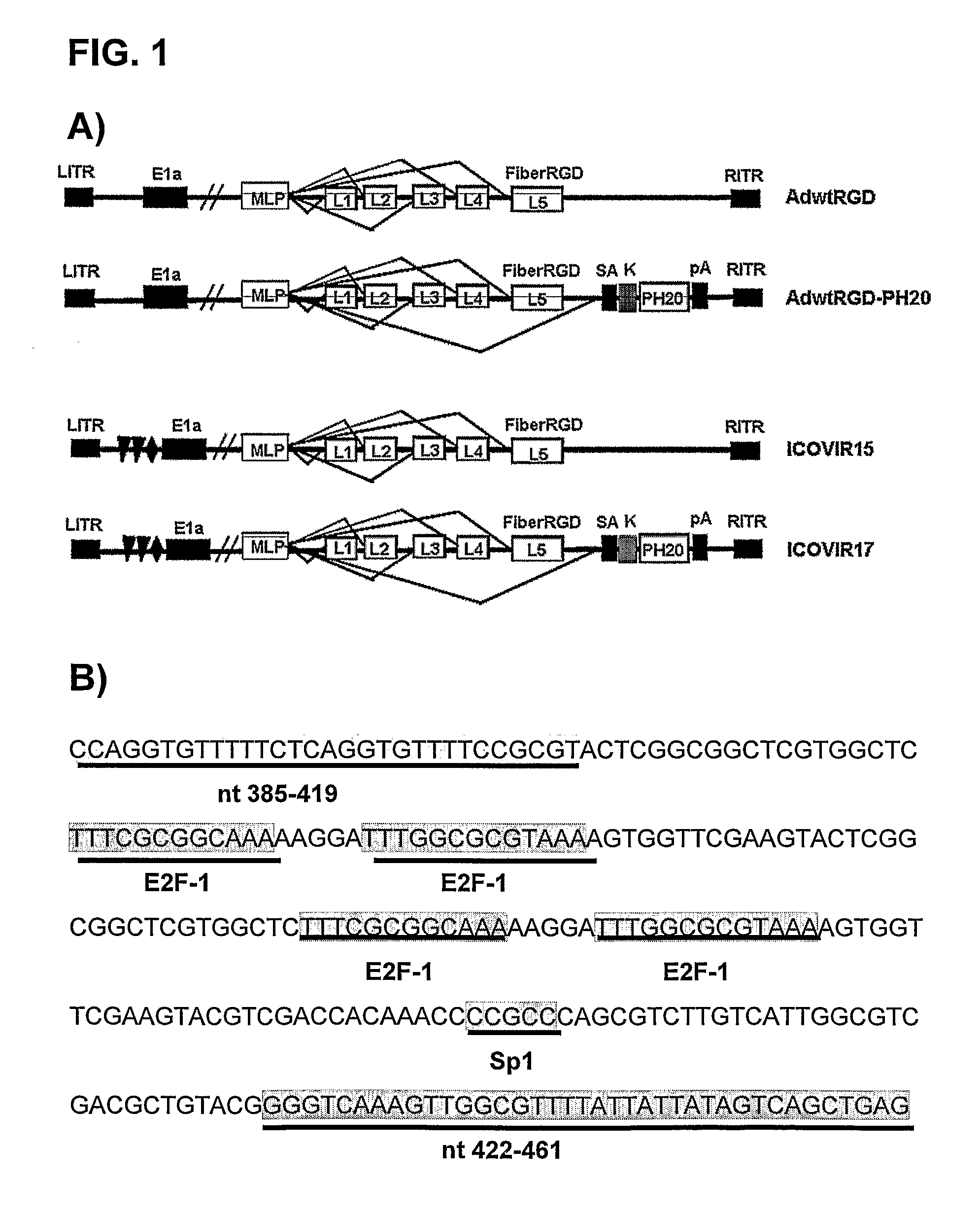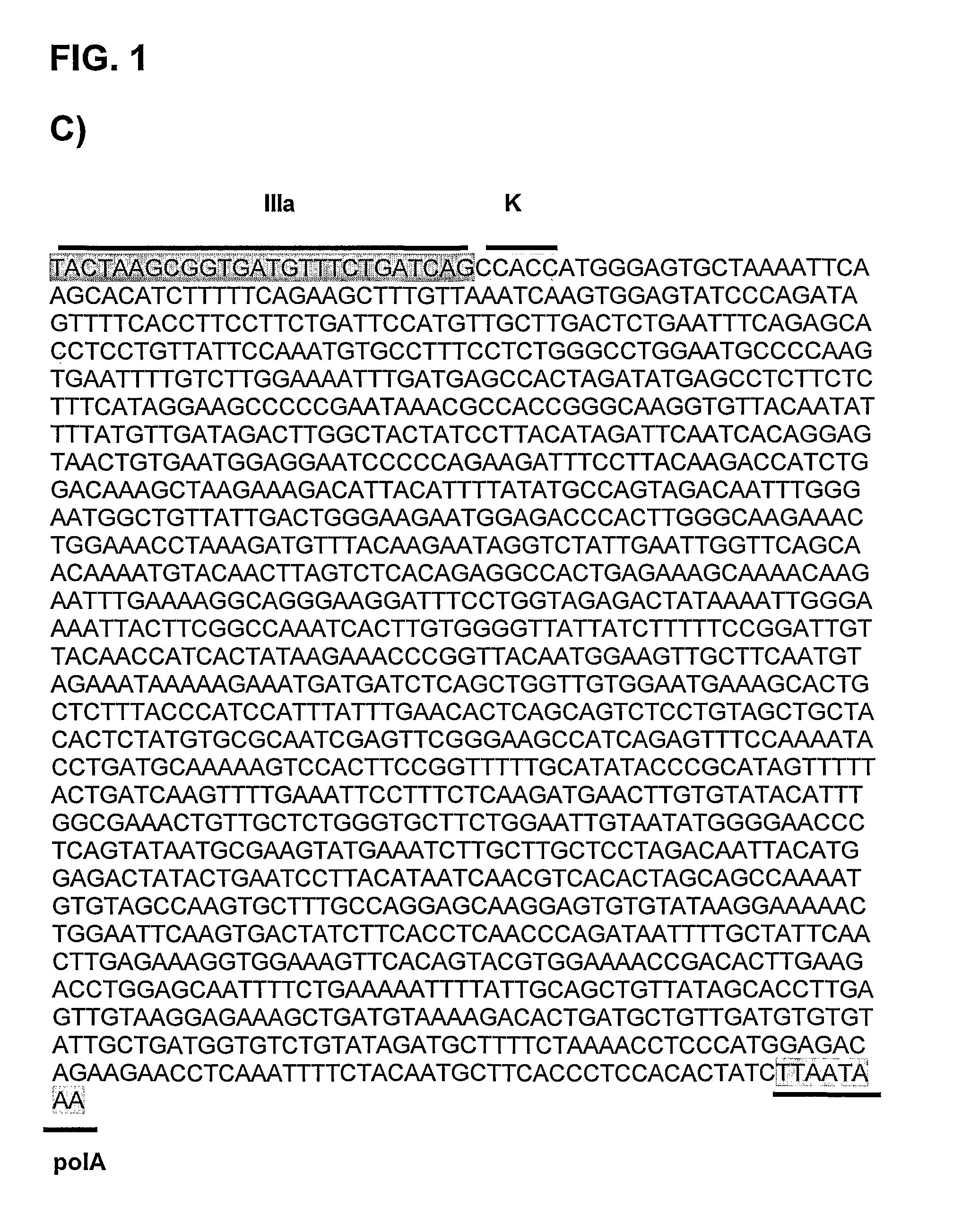Oncolytic adenoviruses for treating cancer
- Summary
- Abstract
- Description
- Claims
- Application Information
AI Technical Summary
Benefits of technology
Problems solved by technology
Method used
Image
Examples
example 1
Construction of the Oncolytic Adenoviruses
[0058]Two oncolytic adenoviruses containing the hyaluronidase PH20 gene were constructed: adenoviruses AdwtRGD-PH20 and ICOVIR17.
[0059]The cDNA of hyaluronidase PH20 was obtained by PCR amplification of the different exons using as a template the A549 cell line genome, followed by joining these exons with specific flanking primers that contain the Mfel restriction site. The resulting fragment was digested with Mfel and cloned by ligation in the shuttle plasmid, pNKFiberRGD (that contains the sequence of the adenovirus fibre modified with RGD), to produce plasmid pNKFiberPH20. The cDNA corresponding to PH20 cloned in plasmid pNKFiberPH20 is in SEQ ID NO: 2. The SEQ ID NO: 2 shows the codifying nucleotides for protein PH20 (isoform with GenBank access number NP—694859.1) from the start codon (ATG) to position 1467. The nucleotide sequence from region 1468 to the 1527 of this GenBank sequence codifies for the hydrophobic tail of the protein tha...
example 2
Construction of AdwtRGD-PH20 Adenovirus
[0060]In order to generate adenovirus AdwtRGD-PH20, the gene of the adenoviral fibre of plasmid pVK50cau (that contains the complete sequence of the Ad5 with a Swa I restriction site in the fibre) was replaced using homologous recombination in yeast by the fibre gene followed by the hyaluronidase PH20 gene obtained from plasmid pNKFiberPH20 digested with NotI / Kpn I.
[0061]The adenovirus AdwtRGD-PH20, characterized by expressing the hyaluronidase PH20 gene under the control of the major late promoter, and by containing the tri-peptide RGD in the adenoviral fibre, was generated by digestion with Pac I of plasmid pAdwtRGD-PH20 and transfection in HEK293 cells. The adenovirus AdwtRGD, previously described, is characterized by containing the tri-peptide RGD in the adenoviral fibre (cfr. M. Majem et al., “Control of E1A to under an E2F-1 to promoter insulated with the myotonic dystrophy locus insulator reduces the toxicity of oncolytic adenovirus Ad-D...
example 3
Construction of adenovirus ICOVIR17
[0062]In order to generate this adenovirus, the adenoviral plasmid pICOVIR17 was used. To generate this plasmid, the adenovirus fibre gene from plasmid pICOVIR15 was replaced by homologous recombination in yeast with the fibre gene followed by the hyaluronidase PH20 gene from plasmid pAdwtRGD-PH20 digested with SpeI / PacI.
[0063]Adenovirus ICOVIR15 derives from adenovirus AdΔ24RGD that is characterized by containing the Δ24 deletion in the E1a protein encoding sequence. This deletion affects the interaction of E1a with pRB. AdΔ24RGD has also the insertion of peptide RGD in the adenoviral fibre to increase the infectivity of the virus. These two modifications are described in K. Suzuki et al., “Conditionally replicative adenovirus with enhanced infectivity shows improved oncolytic potency”, Clin Cancer Res 2001, vol. 7, pp. 120-6. From AdΔ24RGD, four E2F-1 binding sites and one Sp1 binding site were inserted in the endogenous E1a promoter to control t...
PUM
| Property | Measurement | Unit |
|---|---|---|
| Current | aaaaa | aaaaa |
| Solubility (mass) | aaaaa | aaaaa |
Abstract
Description
Claims
Application Information
 Login to View More
Login to View More - R&D
- Intellectual Property
- Life Sciences
- Materials
- Tech Scout
- Unparalleled Data Quality
- Higher Quality Content
- 60% Fewer Hallucinations
Browse by: Latest US Patents, China's latest patents, Technical Efficacy Thesaurus, Application Domain, Technology Topic, Popular Technical Reports.
© 2025 PatSnap. All rights reserved.Legal|Privacy policy|Modern Slavery Act Transparency Statement|Sitemap|About US| Contact US: help@patsnap.com



